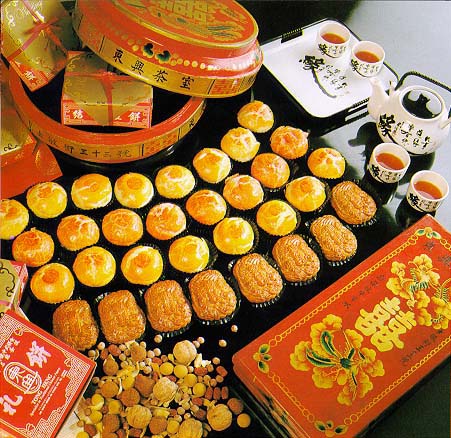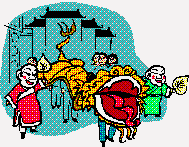Chinese New Year

Gong Xi Fa Cai! On the first day of Chinese New Year
[see calendar], this greeting, which in English means
"Have A Prosperous New Year", will be heard throughout the country where there are Chinese
communities.
It heralds the arrival of the
Chinese New Year - a most auspicious time for the Chinese - and to greet
someone with these words on the first day of the New Year is to wish good
fortune and blessings upon that person.
In China, this joyous period
signals the beginning of spring after a long winter and thus represents
a new start to a hopefully fruitful year. It is a time when, by tradition,
all debts have to be settled to wipe the slate clean. And to mark the occasion,
new clothes and shoes are worn while the entire house is spring-cleaned.
Chinese New Year is a time to renew friendships and foster family harmony.
In Malaysia, the time-old traditions
are carried out each year in most Chinese households. Preparations begin
long before the dawn of the New Year and reach a feverish pitch during
the preceding week. And as with most festivals the gods and ancestors are
venerated and propitiated with much ceremony during this period.
Home are decorated with charm
papers and red banners inscribed with auspicious characters written in
gold paint for luck. A bright-red banner is usually hung over the lintel
of the main door to attract prosperity. On Chinese New Year's Eve, a grand
reunion dinner is held in every household and family members travel from
afar just to be home for this meal.
No effort is spared in preparing
a sumptuous feast and there are usually lots of leftovers. The Chinese
believe that an abundance of food during this time will mean that you will
never want for anything throughout the entire year.
An hour before midnight, the
family gathers to pay homage to the ancestors at the family altar. As the
clock strikes twelve, firecrackers are set off, making a lot of noise to
scare off any evil spirit lurking around. Lights are left burning all night
long and children are encouraged to stay up late in the belief that this
will add a few more years to their parents' life.
In the mornings, the children
dress in new clothes and gather to greet their elders "Gong Xi Fa Cai".
In return, the children are rewarded with an "ang pow" or red packet
containing cash.
Ang pows, considered to
be luck money, are given to children and unmarried people younger than
the giver. Brand new notes are given, usually in even amounts. The more
religious folks observe a vegetarian diet n the first day. The first, second
and fourth days are days for visiting and merry-making. Most Chinese hold
open houses during which friends, including those of othe races, visit
to partake in the merry-making.
The celebrations continue until
the 15th day. The seventh day, which according to Chinese legend is the
birthday of man, is marked by eating "yee sang", a salad made up
of thinly-sliced raw fish, shredded carrots, turnips, lettuce, pickles
and some spices.
The ninth day, the birthday of
the Jade Emperor, is a special day for the Chinese, especially the Hokkien
community who make a special offering to the God of Heaven, as he is also
known. A high table laden with chicken, friend cuttle fish, pomelos, tortoise
buns and mandarin oranges, is set out in the open.
The New Year festivities end
with a grand finale on Chap Goh Meh, the 15th day. Many houses are
illuminated and lanterns are hung on this night while feasts are held.

Chap Goh Meh
On the 15th day of the first
month, which is the night of the first full moon of the year, the Chap
Goh Meh is celebrated as a sort of Chinese Valentine's Day. It is marked
by quaint and colourful traditions that are very Malaysian.
The celebrations of Chap Goh
Meh stems from age old traditional practices of the Chinese. Many years
ago, the evening of Chap Goh Meh was first heralded by the explosions
of fire crackers in the belief that the noise it created would scared away
lurking evil spirits or ghosts. This was usually followed by a night out
for the young maidens who would parade in their carriages around town.
The route would inevitable include the crossing of bridges as it was symbolic
of changing one's luck for the better.
This is then the time for the
many male spectators to admire these maidens who ventured out in teir resplendent
clothes and jewellry. The waterfront areas then popular gathering points.
Chap Goh Meh wa also believed to be a night where youths and maidens
made wishes by throwing oranges and red dates into the water, as it was
believed that wishes made on this night were more willingly granted by
the heavenly powers.


